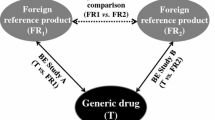Abstract
The International Conference on Harmonisation (ICH) of Technical Requirements for Registration of Pharmaceuticals for Human Use M9 Guidelines for Biopharmaceutics Classification System Biowaivers reached harmonization in November 2019. However, guidelines for bioequivalence studies are not internationally harmonized, and water as a dissolution medium is only required in Japanese guidelines, regardless of drug solubility. This study investigated the dissolution profiles of generic products in Japan that differ from those of original drugs in dissolution media defined in guidelines. Dissolution profiles disclosed on websites of generic manufacturers were investigated for 262 active ingredients listed in the bluebook (4638 oral solid products listed in the National Health Insurance drug price list) issued by the Ministry of Health, Labour and Welfare. 5% of all generic products were different from the original products in dissolution media, of which 20% was observed in water only. Among the active pharmaceutical ingredients that showed different dissolution profiles only in water, the ratio of original products that showed slower dissolution profiles to the generics was 73%. The ratio of products showing different dissolution in water only was higher than in other media investigated in this study; however, these do not reflect disintegration and dissolution of drug products in the gastrointestinal tract, since bioequivalence has been confirmed in human studies and the generic products were approved by Japanese authorities. Therefore, a discussion about the required use of water as a dissolution medium in the Japanese guidelines is needed among industry, academia, and regulatory authorities.



Similar content being viewed by others
References
Japan Ministry of Health, Labour and Welfare. Guideline for bioequivalence studies of generic products. https://www.nihs.go.jp/drug/index-E.html#BE.
Japan Ministry of Health, Labour and Welfare. Guideline for bioequivalence studies for different oral solid dosage forms. https://www.nihs.go.jp/drug/index-E.html#BE.
Japan Ministry of Health, Labour and Welfare. Guideline for bioequivalence studies of generic products for different strengths of oral solid dosage forms. https://www.nihs.go.jp/drug/index-E.html#BE.
Japan Ministry of Health, Labour and Welfare. Guideline for bioequivalence studies for formulation changes of oral solid dosage forms. https://www.nihs.go.jp/drug/index-E.html#BE.
EMA Guideline. Guideline on the investigation of bioequivalence. https://www.ema.europa.eu/en/documents/scientific-guideline/guideline-investigation-bioequivalence-rev1_en.pdf.
FDA Guidance for industry. SUPAC-IR: immediate release solid oral dosage forms. https://www.fda.gov/regulatory-information/search-fda-guidance-documents/supac-ir-immediate-release-solid-oral-dosage-forms-scale-and-post-approval-changes-chemistry.
FDA Guidance for Industry. SUPAC-MR: modified release solid oral dosage forms. https://www.fda.gov/regulatory-information/search-fda-guidance-documents/supac-mr-modified-release-solid-oral-dosage-forms-scale-and-postapproval-changes-chemistry.
ICH M13: Bioequivalence for immediate-release solid oral dosage forms https://database.ich.org/sites/default/files/ICH_M13_Business_Plan_2020_0710.pdf.
FDA Guidance for industry. Bioavailability and bioequivalence studies submitted in NDAs or INDs; General Considerations. https://www.fda.gov/regulatory-information/search-fda-guidance-documents/bioavailability-and-bioequivalence-studies-submitted-ndas-or-inds-general-considerations.
Japan Ministry of Health, Labour and Welfare. Q&A for guideline for bioequivalence studies for different oral solid dosage forms and formulation changes. https://www.nihs.go.jp/drug/index-E.html#BE.
Drug approval and licensing procedures in Japan 2018; Jiho:256 (In Japanese)
Japan Ministry of Health, Labour and Welfare. Q&A on the Good Manufacturing practice for investigational products. https://www.mhlw.go.jp/web/t_doc?dataId=00tb5533&dataType=1&pageNo=1(in Japanese)
International Council for Harmonisation of Technical Requirements for Registration of Pharmaceuticals for Human Use. ICH harmonised guideline, biopharmaceutical classification system-based biowaiver M9. https://www.ich.org/page/multidisciplinary-guidelines.
Ministry of Health, Labor and Welfare in Japan. National Health Insurance drug price list. https://www.mhlw.go.jp/topics/2020/04/tp20200401-01.html(in Japanese)
Ministry of Health, Labor and Welfare in Japan. Bluebook. https://www.nihs.go.jp/drug/ecqaged/bluebook/list.html(in Japanese)
Document about equivalency and similarity of dissolution for OLANZAPINE Fine Granule 1% “YOSHITOMI”. https://www.nipro-es-pharma.co.jp/product/di/filedownloader4mtrx.php?pid=6502&ftid=12&fnum= (in Japanese)
Interview form for OLANZAPINE Fine Granule 1% “Meiji”. https://www.info.pmda.go.jp/go/interview/1/780009_1179044C1111_1_1F.pdf(in Japanese)
Interview form for OLANZAPINE Fine Granule 1% “DSEP”. https://www.info.pmda.go.jp/go/interview/1/430773_1179044C1030_1_1F.pdf(in Japanese)
Document of dissolution profile for OLANZAPINE ODT “YOSHITOMI”. https://www.nipro-es-pharma.co.jp/product/di/filedownloader4mtrx.php?pid=6500&ftid=12(in Japanese)
Interview form for CAMSHIA Combination Tablet “TAKEDA TEVA”. https://www.info.pmda.go.jp/go/interview/1/400813_2149116F1063_1_003_1F.pdf(in Japanese)
Interview form for FUROSEMIDE Tablet “TAKEDA TEVA”. http://image.packageinsert.jp/pdf.php?mode=1&yjcode=2139005F1087(in Japanese)
Ministry of Health, Labor and Welfare in Japan. Japanese pharmacopoeia. https://www.mhlw.go.jp/file/06-Seisakujouhou-11120000-Iyakushokuhinkyoku/JP17_REV.pdf.
Hamaura K. Each challenge of dissolution test in guideline for bioequivalence study. Paper presented at 10th Pharmaceutical quality forum. December 10, 2010; Japan. http://www.nihs.go.jp/drug/PhForum/documents101215/hamaura101215.pdf(in Japanese)
FDA Guidance for Industry. Dissolution Testing of Immediate Release Solid Oral Dosage Forms. https://www.gmp-compliance.org/files/guidemgr/1713bp1.pdf.
International Council for Harmonisation of Technical Requirements for Registration of Pharmaceuticals for Human Use. ICH harmonised guideline, biopharmaceutical classification system-based biowaiver M9 (step 2b). https://www.ema.europa.eu/en/documents/scientific-guideline/ich-m9-biopharmaceutics-classification-system-based-biowaivers-step-2b-first-version_en.pdf.
Kararli T, Firchhoff C, Truelove J. Ionic strength dependence of dissolution for Eudragit S-100 coated pellets. J Pharm Res. 1995;12(11):1813–6.
Karkossa F, Klein S. Assessing the influence of media composition and ionic strength on drug release from commercial immediate release and enteric-coated aspirin tablets. J Pharm Pharmacol. 2017;69:1327–40.
Funding
The author(s) received no financial support for the research, authorship, and/or publication of this article.
Author information
Authors and Affiliations
Contributions
EK and HK conducted the survey. EK wrote the manuscript with support from HK. All authors have discussed the results and contributed to the final manuscript. MS supervised the project.
Corresponding author
Ethics declarations
Conflict of interest
The author(s) declare no potential conflicts of interest with respect to the research, authorship, and/or publication of this article.
Rights and permissions
About this article
Cite this article
Kajiwara, E., Kamizato, H. & Shikano, M. Dissolution Profiles of Generic Products in Dissolution Media Defined by Japanese Guidelines for Bioequivalence Studies. Ther Innov Regul Sci 55, 1096–1100 (2021). https://doi.org/10.1007/s43441-021-00312-w
Received:
Accepted:
Published:
Issue Date:
DOI: https://doi.org/10.1007/s43441-021-00312-w




